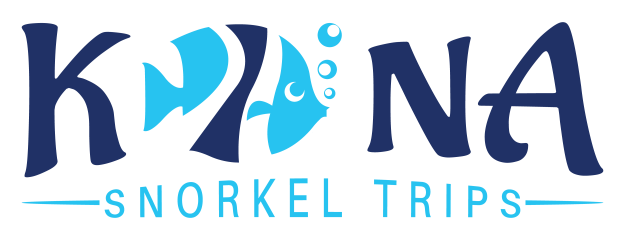Kona Manta Ray Night Snorkel Kona | Ultimate Guide & Tips
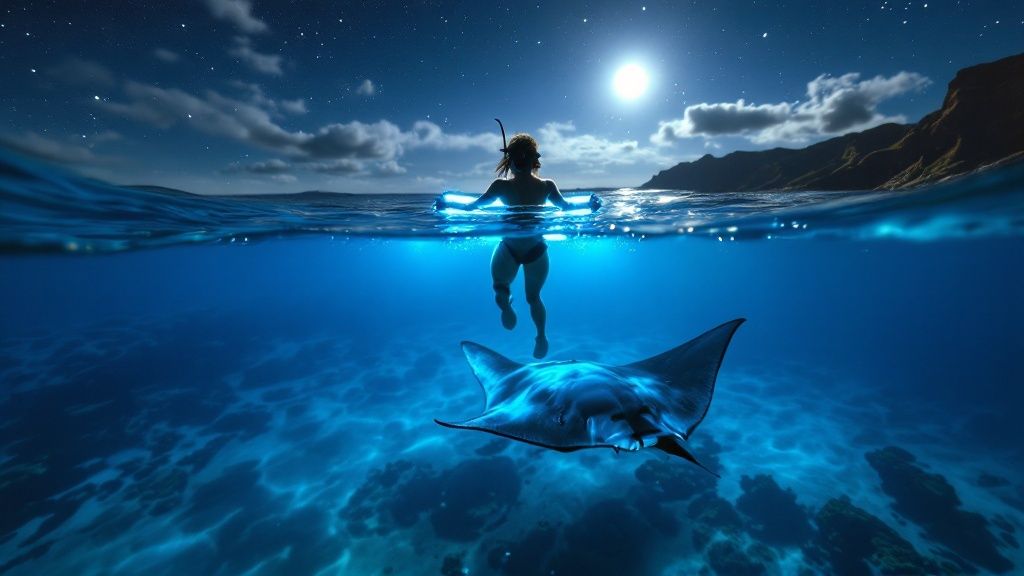
Picture this: you’re floating in the warm, dark Pacific Ocean. Just inches beneath you, colossal, gentle giants with wingspans stretching over 12 feet glide and dance through the water. This isn't a scene from a nature documentary—it's the unbelievable reality of the manta ray night snorkel in Kona. It’s a true bucket-list adventure that people travel from all over the world to experience.
What makes this so special is that it’s accessible to just about everyone, no matter your swimming skills. It’s an experience you’ll be talking about long after your trip to the Big Island is over.
Why Kona is the Manta Ray Capital of the World
Kona isn’t just a good place to see manta rays; it’s hands-down the most reliable and famous spot on the planet for this specific encounter. The Kona coast has a unique underwater geography that sets the stage for a nightly spectacle you just can't find anywhere else. When you book a tour, you’re not just hoping to see mantas—you're basically guaranteed a front-row seat to a world-famous eco-event.
Here at Kona Snorkel Trips, sharing these magical moments is what we do best. We're proud to be known as the top-rated and most-reviewed snorkel company in Hawaii, and that comes from a deep commitment to safety and making sure every single guest has an unforgettable time.
An Incredible Sighting Success Rate
What really puts Kona on the map is the sheer consistency of the sightings. This is the world’s number one spot for manta ray night snorkeling for a reason: we have an unbelievable 80–90% year-round success rate. That’s why around 80,000 people jump in the water here every year—the chance of an up-close encounter is just that high.
This incredible reliability is all thanks to a few established feeding sites, like the famous Garden Eel Cove. Over the years, tour operators have helped create a sustainable and predictable environment where the mantas know they can find a meal. To get a better sense of what makes this spot so special, check out our guide on Garden Eel Cove, a manta ray heaven in Kona.
A Tour Designed for Everyone
The best part about the manta ray night snorkel is how accessible it is. You really don't need to be a pro swimmer or a certified diver to join in.
Everyone holds onto a custom-built light board that floats on the surface. These boards shine bright lights down into the water, which attracts plankton—the manta rays' favorite food. Your only job is to float, watch, and be completely amazed as these gentle giants perform their underwater ballet right below you. If you're exploring options, Manta Ray Night Snorkel Hawaii is an exceptional alternative when looking for a Manta Ray night snorkel tour.
Choosing Your Perfect Manta Ray Tour
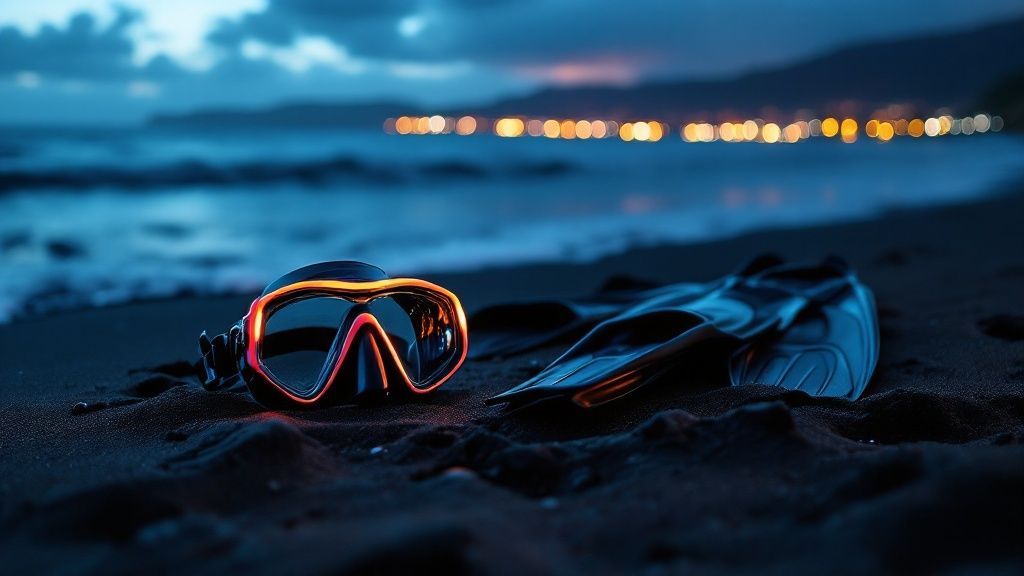
With so many companies offering the manta ray night snorkel in Kona, picking the right one can feel a little daunting. The big secret? The "best" tour really depends on you—your group, your comfort level, and the kind of vibe you're looking for. Not all manta ray tours are created equal.
The first choice you'll likely face is between a small, zippy boat and a larger, more stable vessel. The smaller boats, often rigid-hulled inflatables, can be a blast. They offer a faster, more thrilling ride out to the site and a really intimate feel with just a handful of other people.
On the other hand, bigger catamarans provide a much smoother journey. They often come with amenities like onboard restrooms and more space to spread out, which is a huge plus for families or anyone who gets a little queasy on the water.
Finding the Right Fit for Your Group
Think about who you’re traveling with. A small-boat adventure is perfect for a couple or a few friends looking for an adrenaline rush. But if you’ve got young kids or older parents in tow, the comfort and stability of a larger boat will probably make for a much better evening for everyone.
Beyond the boat's size, every company has its own personality. Some crews are all about high energy and good times, while others take a more educational approach, diving deep into marine biology. The best way to get a feel for a company's vibe is to read recent reviews from other snorkelers.
For a really in-depth look at how different tours stack up, check out our detailed guide on the best manta ray night snorkel tours in Kona.
Non-Negotiables: Safety and Sustainability
While the style of the tour is up to you, a few things should be non-negotiable. At the top of that list are safety and a deep commitment to protecting the manta rays. The best operators follow strict guidelines to make sure these incredible animals are respected and unharmed.
Crucial Tip: Always book with an operator that follows Manta Ray Green List standards. This means they enforce a strict "observe only, no touching" policy and give clear instructions to snorkelers to avoid disrupting the mantas' natural feeding behavior.
Your chosen operator must have a stellar safety record. It's something you just can't compromise on. If you want to get familiar with what good practices look like, The Ultimate 2025 Boat Safety Checklist: 7 Essential Checks is a great resource. Look for companies with experienced, certified guides and gear that's clearly well-maintained.
When you're comparing tour companies, it's a good idea to have a mental checklist. This table can help you ask the right questions and figure out who's truly committed to a great, safe experience.
Kona Manta Ray Tour Operator Checklist
| Feature to Check | Why It Matters | What to Look For |
|---|---|---|
| Safety Briefing | A thorough briefing shows professionalism and prepares you for being in the dark ocean. | Do they explain what to do, what not to do, and emergency procedures before you get in? |
| Guide Experience | Knowledgeable guides enhance the experience and are crucial for safety. | Are guides certified in first-aid/CPR? Do reviews mention them by name and praise their expertise? |
| Gear Quality | Leaky masks or torn wetsuits can ruin your night and even be a safety issue. | Is the snorkel gear and wetsuit clean and in good repair? Do they have various sizes? |
| Manta Guarantee | This shows confidence in their process and protects your investment. | What's the policy if no mantas show up? Reputable companies often offer a free re-booking. |
| Eco-Practices | Supporting responsible operators protects the mantas for future generations. | Do they mention the Manta Ray Green List? Do they emphasize a "no touching" policy? |
Asking these kinds of questions doesn't just guarantee you'll have an incredible time. It also ensures your money supports a company that cares about your safety and the health of Kona's precious marine ecosystem.
What to Expect On Your Manta Ray Adventure
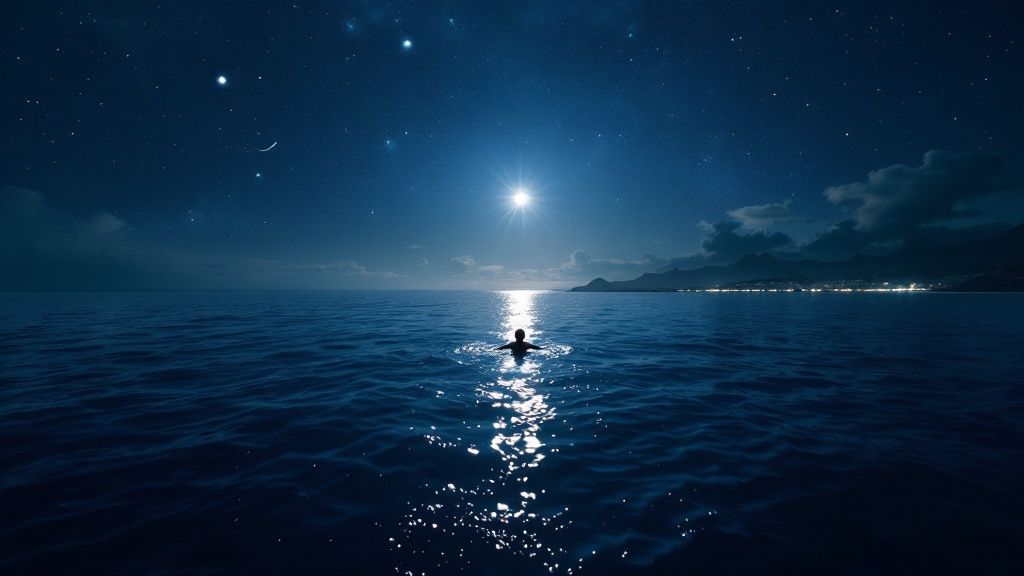
The whole experience kicks off the second you check in at the harbor. There's a buzz in the air as the sun starts to dip, painting the Kona coast in incredible colors. You’ll meet the crew, get fitted for your gear, and feel the excitement really start to build. This is where your manta ray night snorkel Kona adventure begins.
First up is a thorough safety briefing. Our crew are pros, and they'll walk you through everything—how to use your gear, the best way to be in the water with the mantas, and what to look out for. They're there to answer any questions, making sure everyone feels totally comfortable before we even think about leaving the dock.
The boat ride out to the manta site is short, but it's one of my favorite parts of the trip. Cruising along the coast while the last bits of daylight fade and the stars pop out is the perfect, peaceful transition into the magic that’s about to happen.
Entering the Manta's World
Once we drop anchor, it’s go-time. The crew will help you slide into the warm Pacific, where a big, floating light board is waiting. Think of this custom-made raft as your front-row seat for the show. Its powerful lights shine straight down into the dark water, acting like a dinner bell for swarms of plankton.
And your job? It's simple. Just hold onto the board, float on the surface, and watch. That's it. There’s no hard-core swimming involved, which makes this an adventure almost anyone can join.
This gentle, floating observation is the heart of the whole thing. The wetsuit keeps you warm and buoyant, letting you just relax and get lost in the underwater world unfolding just inches below you.
The entire tour usually runs about 1.5 to 2 hours from check-in to return, and you'll spend a good chunk of that time floating with the mantas. You don’t have to be an amazing swimmer; it's super beginner-friendly and perfect for families, couples, or solo travelers. We've got more insights on what makes this tour so accessible on our blog.
The Main Event Unfolds
The first time you see a manta appear is a moment you won't forget. It’s genuinely breathtaking. A huge, graceful shadow emerges from the deep, gliding into the light beams like it's weightless. Before you know it, more might join, creating a silent, mesmerizing ballet right in front of you. They swoop and somersault, barrel-rolling with their giant mouths open to filter the plankton.
These gentle giants, some with wingspans over 12 feet, get so close you can see the unique spot patterns on their bellies. It’s a surreal, quiet, and deeply moving experience. After about 45 minutes in the water, you’ll climb back on the boat for a peaceful, starlit ride back to the harbor, your head filled with the incredible performance you just witnessed.
How to Prepare for Your Night Snorkel
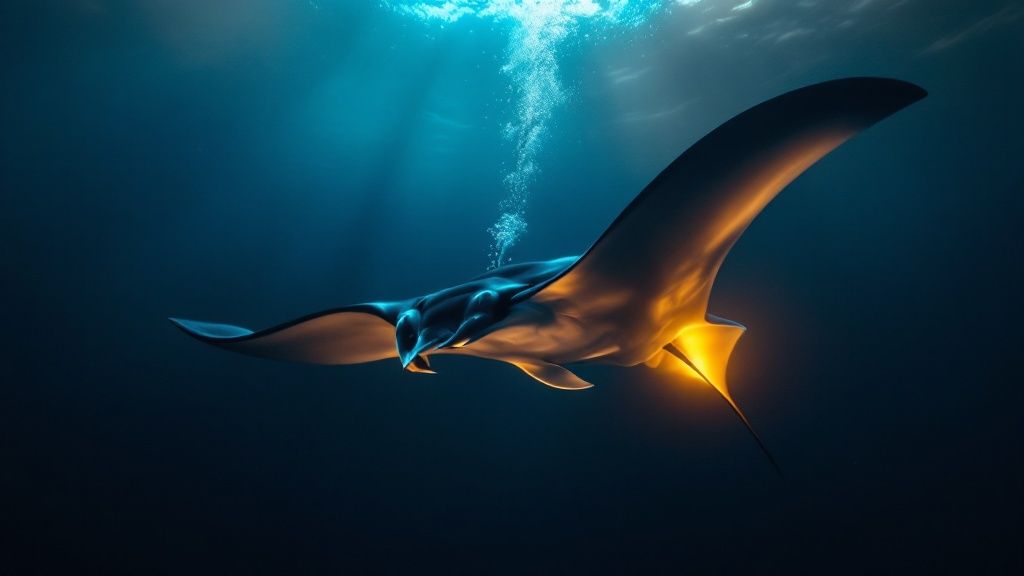
A little prep work goes a long way toward making your manta ray night snorkel in Kona comfortable and unforgettable. When you show up relaxed and ready, you can soak in every moment of the magic without a single distraction. The good news? It's really easy to get ready.
Any reputable tour operator will have the core gear covered for you. They'll provide a quality snorkel, mask, fins, and a wetsuit—which is a huge plus. The wetsuit not only adds buoyancy but also keeps you surprisingly warm in the Pacific after the sun dips below the horizon.
Still, there are a few personal items you’ll be glad you brought along. Packing smart ensures you're comfortable on the boat before your snorkel and, just as importantly, after you get out of the water.
What to Pack for Your Snorkel Tour
Honestly, packing for this adventure is all about comfort. You don't need a lot, but having the right things can make your evening so much more enjoyable.
Here’s a quick checklist of the essentials:
- A Towel and Change of Clothes: This is non-negotiable. You’ll want something warm and dry to slip into for the boat ride back to the harbor. A hoodie or a light jacket is perfect for cutting the ocean breeze.
- Swimsuit: The easiest way to do it is to just wear your swimsuit under your clothes when you show up. It makes getting ready on the boat a breeze.
- Reusable Water Bottle: Make sure you're hydrated throughout the day before your tour even starts. Most boats have fresh water for refills.
- Underwater Camera: If you have a GoPro or another waterproof camera, this is the time to bring it! The powerful lights from the manta board create the perfect conditions for some truly mind-blowing photos and videos.
For a deeper dive into what to bring on any Big Island snorkel trip, check out our complete guide on the best gear for snorkeling in Hawaii.
Insider Tips for a Stress-Free Experience
Beyond your packing list, a couple of pro tips can make a world of difference. The big one is motion sickness. If you have even the slightest suspicion you might feel queasy on the boat, take your preferred medication at least an hour before you board. This gives it plenty of time to kick in.
Pro Tip: Don't wait until you start feeling sick to take something. By that point, it’s usually too late. A little proactive planning is the key to a smooth ride.
Also, it’s best to leave your valuables at your hotel. Things like nice jewelry, your full wallet, and any electronics you don't need should stay behind. The boats are secure, but it’s just easier to travel light and not have to worry about your stuff. The crew's job is to focus on your safety and the mantas, and your job is to focus on the gentle giants you’re about to meet.
Ever wonder what makes the manta ray night snorkel in Kona so reliably incredible? It's not just a lucky break; it’s a brilliant bit of marine biology that tour operators figured out how to tap into, creating a nightly underwater banquet for these gentle giants. The whole spectacle boils down to a simple, yet powerful, chain reaction.
It all starts with the smallest stuff in the ocean: phytoplankton and zooplankton. These microscopic critters are the foundation of the marine food web, and they have one key trait—they’re drawn to light. When our boats pull up to the snorkel sites after the sun goes down, we switch on powerful underwater lights that beam down into the dark water.
This flood of light is like a massive magnet for the plankton. Within just a few minutes, the water column is thick with the stuff, creating a concentrated, all-you-can-eat buffet. And for Kona's resident population of reef manta rays, that’s a dinner bell they simply can't ignore.
Manta Village vs. Manta Heaven
We have two main spots for this nightly feeding frenzy: 'Manta Village,' just south of Kailua-Kona, and 'Manta Heaven' (also known as Garden Eel Cove) up north. These sites weren't picked at random; they're natural manta habitats. The consistent presence of tour boats and their lights has simply conditioned the local manta population to associate these spots with a guaranteed meal.
Interestingly, the vibe can be a little different at each site. Research has shown that while both are fantastic, Manta Heaven often pulls in a larger crowd. In one year-long study, observers noted up to 30 distinct individuals showing up at Manta Heaven in a single month. The nightly average was also noticeably higher there (around 11 mantas) compared to Manta Village (about 4). It just goes to show how each spot has its own unique patterns. You can dig into more of the fascinating manta sighting statistics if you're a data nerd like me.
A Deeper Connection with Kona’s Mantas
What makes this experience truly special is that the local manta population is one of the most well-studied in the world. Many of the mantas you'll see have names, and local guides and researchers have been tracking them for years.
The unique spot pattern on a manta ray’s belly is like a human fingerprint—no two are the same. This is how we can recognize individuals like "Big Bertha," "Lefty," or "Kailey," and follow their life stories, sometimes for decades.
So when your guide points out a specific manta by name, you’re not just looking at a random fish. You’re meeting a known member of a cherished local community. Understanding the science and the personal history behind these animals completely changes the snorkel. It goes from a cool tourist activity to a genuinely profound experience with a beautiful and complex ecosystem.
Got Questions About the Manta Ray Snorkel?
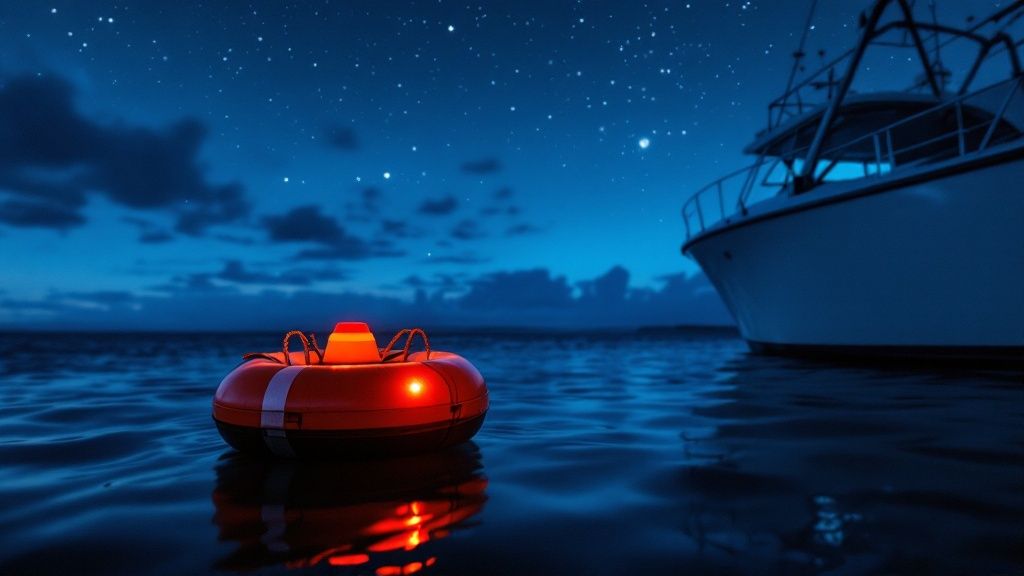
Even after learning all about the magic of the manta ray night snorkel in Kona, it's totally normal to have a few lingering questions. Let's tackle some of the most common ones we hear from guests. Our goal is to clear up any final doubts so you can book your adventure with total confidence.
The number one question on almost everyone’s mind is about safety. I get it. Floating in the dark ocean with giant sea creatures sounds intimidating. But the truth is, the manta ray night snorkel is extremely safe when you go with a professional, reputable tour operator.
Manta rays themselves are completely harmless. People often call them "gentle giants," and it's the perfect description. They are filter feeders with no teeth, stingers, or barbs. Their interest in us is purely curiosity.
Your safety is the crew’s absolute top priority. From the detailed pre-snorkel briefing to having experienced guides right there in the water with you, every step is carefully managed.
Do I Need to Be a Strong Swimmer?
This is a big one, and the answer is a definitive no. One of the absolute best things about this experience is how accessible it is. You'll do very little actual swimming.
The whole time you're in the water, you'll be floating peacefully on the surface while holding onto a large, custom-designed light board. Think of it as your personal, stable viewing platform.
On top of that, the wetsuit you'll be wearing provides a lot of buoyancy, helping you float without any effort. Most companies also provide extra flotation like pool noodles for anyone who wants a little more peace of mind. Your only job is to relax, float, and watch the incredible show happening just a few feet below.
What if We Don't See Any Manta Rays?
This is a fair question. While Kona boasts an exceptionally high success rate for manta sightings—often over 90%—we have to remember these are wild animals in their natural habitat. Their appearance can never be absolutely guaranteed.
On the rare occasion that the mantas decide to skip dinner, reputable tour operators have policies in place to take care of you.
The standard in the industry is often called a "manta guarantee." If your tour doesn't see any mantas, most companies will offer to re-book you on another tour for free on a different night, based on availability. Always double-check a company's specific policy before you book.
This is exactly why we always recommend scheduling your manta ray snorkel early in your trip. That way, if you happen to be on one of those very rare unlucky nights, you have plenty of time in your vacation schedule to take them up on that re-booking offer.
Are We Allowed to Touch the Manta Rays?
This is the single most important rule of the entire experience: you are absolutely not allowed to touch the manta rays. No exceptions. This rule exists purely for the protection and well-being of these magnificent creatures.
Manta rays have a special protective mucous layer covering their skin. This slime coat is their primary defense against harmful bacteria and infections. Touching a manta, even with the lightest graze, can rub off this delicate coating and leave them vulnerable to disease.
Responsible eco-tourism is all about passive, respectful observation. Your guides will show you exactly how to position yourself in the water to give the mantas plenty of space to swim and feed without feeling crowded. By simply watching, you help ensure these animals stay healthy and continue to grace the Kona coast for generations.
Ready for an experience you'll be talking about for years? Kona Snorkel Trips is Hawaii's top-rated and most-reviewed snorkel company, and we'd love to share the magic of the mantas with you. Book your unforgettable manta ray night snorkel tour today
